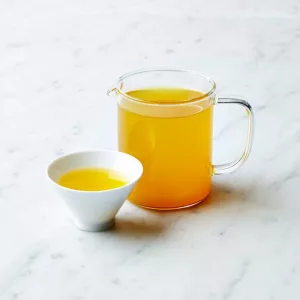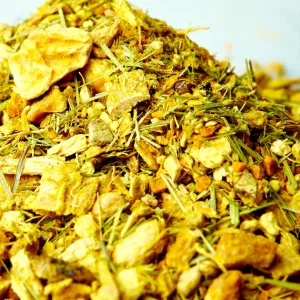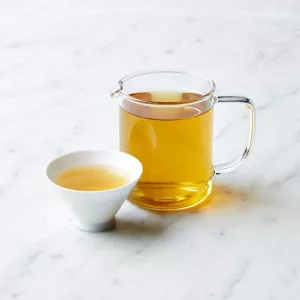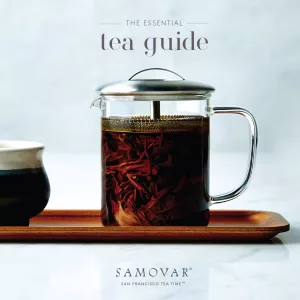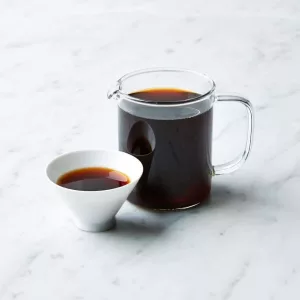![]() Industry Roundtable (Part One): San Francisco Speaks
Industry Roundtable (Part One): San Francisco Speaks
by Lindsey Goodwin
With close ties to the Far East, San Francisco has always been a beacon of the United States tea business. During a recent trip to the Bay area, WTN Contributing Editor Lindsey Goodwin spoke with leading tea room owners and tea retailers to get the pulse of the industry.
Participating were Roy Fong, co-founder of Imperial Tea Court, Jesse Jacobs, owner of Samovar Tea Lounge, Jill Portman, co-founder of Mighty Leaf Tea, Winnie Yu, founder of Teance, and Chongbin Zheng, co-founder of Red & Green Company. Highlights of the interviews follow.
WTN: What has been the most important change in the Bay Area tea scene since the American tea revival began?
Portman: There’s a really significant demand for whole leaf, but also for convenience. Customers won’t drink inferior quality in traditional bags, but now there are 20 to 30 companies offering similar products to ours, which we pioneered in the 1990s.
Yu: I think the biggest thing is the availability and recognition of high quality, premium loose-leaf tea. In the 1990s you were finding a lot of blended, herbal or black American-type teas. Now authentic, unblended, premium teas are much more available and appreciated.
Jacobs: I agree, but it’s more than just the tea. It’s the appreciation of the tea lifestyle and what tea represents, like awareness of health, relaxation, sustainability, artisanal products and Slow Food.
Fong: I think those things are important, but more importantly… You know how people drink tea in the Orient as a matter of course, like people in Italy drink coffee as a matter of course? People readily accept tea now, like “This is what you do.” It is so acceptable, you don’t even think of it as extraordinary, but it’s a drastic change from when I opened the first traditional Chinese tea house (in 1993), when people would ask, “Is it in a bag or not?” The first big step was getting beyond bags, and then the question was, “Is it a green tea or a black tea?” Now people know white tea and puer, and ask which region, year, factory and item number a puer is. These changes creep up on you, but it’s so drastic.
Zheng: Since 2005, there are many newspapers, publications, magazines, where people are talking about teas. People are really aware, and asking a lot of questions about teas. … Also, tea has expanded to many areas, and to a fusion of traditional and Western styles while staying pure. They’re in different geographical areas where you wouldn’t expect (them) to succeed, like Samovar in The Castro. There are even outlets in shopping malls, and the Asian Art Museum here has a lot of tea events and programs. … It’s very interesting – all types of people find access to tea. It’s almost like grassroots.
WTN: What are your thoughts on the current state of tea in the Bay Area?
Yu: We call this city “the hotbed of the tea renaissance.” Tea houses showcase teas through fusion and bridge the gap between ethnic shops that offer teas and more accessible, modernized and mainstream, but authentic, formats.
Jacobs: I believe the Bay Area is the epicenter for tea culture in North America, due in part to the weather, which works for hot and iced tea, and because there are many different cultures in a small area. Also, San Francisco is very progressive. It’s a hotbed of new ideas. I can’t think of another area in the world that has all those three things together. It has allowed tea culture to take off. Sure, people drink Moroccan mint tea in Morocco as daily life, but they definitely don’t drink Japanese gyokuro or tea from a samovar. There’s nowhere else with a more international tea culture.
Zheng: San Francisco is pretty provincial and small compared to New York. There’s less distraction. If you have five or six tea stores in the city, everybody knows. The level of competition is very high in terms of getting high quality teas. People in Berkeley and Palo Alto are also very into tea. I live in Marin County, and they include tea tastings in county fairs along with the art, crafts and local foods.
WTN: What are the major business trends in the industry now?
Fong: I think the industry will stabilize, like anything else. A few years ago, at the Fancy Food Show, there were many tea companies cropping up. Now there are fewer new businesses. There are companies who have built up reputations and consistency, and they will do well. In China, they say that people do not stay rich or poor for more than three generations, and a business rarely lasts longer than three generations, but the exception is tea. There’s so much to tea that one generation cannot learn it all.
Yu: Education and sustainability are big trends. We’re dealing with a very educated consumer here in the Bay Area, but the education level is still so far from where it needs to be for them to really appreciate these teas. We need to help people build their palates and learn about tea through classes and events.
Jacobs: Education is also one of our foundations, but not in terms of specific classes. Winnie (Yu) does that really well, and educates the public very deeply. (At Samovar) we like to share knowledge without making it overt. We like making it fun and easy, and letting it resonate on a deep level.
Portman: I think that tea starts with education. Without education, one isn’t drawn to a product.
WTN: What about sustainability?
Jacobs: Nowadays, people are super-sensitive and observant of sustainability. Is something good for me and my wallet and my taste buds and the environment? Will it make me feel good? Does it support the farmers? That’s the metric for our customers.
Zheng: Sustainable packaging materials are important, too. I use bamboo for about 70 percent of my packaging.
Portman: We use biodegradable, corn-based bags with unbleached cotton strings.
Fong: Five years ago, organic tea from China was not readily available. Now I sell close to 100 tons of organic tea a year, which is pretty phenomenal for a small company like mine. In retail, certified organic tea makes up 30 to 35 percent of my sales. I’m surprised fair trade didn’t take off. In the tea business, you have to sell organic tea, but you don’t have to sell fair trade tea. The fair trade people charge so much, there’s no motivation from the merchant side, because it costs so much. With organics, it’s easy for merchants to believe in it and sell it.
Portman: We work in a more project-based way as opposed to feeding the TransFair offices. We are creating a foundation just for that, and have been giving back to gardens for the last three to four years in the form of schools, eyeglass programs, a senior center. … Our volume is becoming quite significant, so we can ensure that our gardens are implementing best practices.
WTN: What are the local changes you’ve seen since the economic turbulence began?
Jacobs: We opened during the dot-com bust along with a bunch of other places. Now it’s the changing of the second guard. There are places that are opening and closing, because the reality of this industry is that it’s tough to make a profit.
Fong: It’s hard to make a living selling only tea. It’s even harder if you only sell what you like. Each place has to do something well. I try to get better at the things I excel in every day. Anywhere with that approach, I think they will succeed.
Yu: People are responding to sales more, but we still have the same clientele. There’s less foot traffic, but when they’re here they buy the same things. Maybe they’re just not leaving their homes, but our buying patterns are the same, and the expensive teas are still moving. Once people recognize a certain quality, it’s hard for them to give up. Tea is not a replaceable product for people. They just want to buy it a lower price.
Zheng: We just did a (retail) warehouse sale. Our teas sold like hotcakes.
Pull Quote: Jacobs: I think that people will pull back on bigger spending and continue to spend on tea like they did in the dot-com bust. Our average price point is $10, and our goal is to make you feel better than you did when you walked in. It’s like the cheapest spa treatment you’ll ever experience.
A cup of coffee is $4, and a pot of tea is $5 and makes 20 cups. It doesn’t matter how expensive it is if there’s value. Our downtown location is up 50 percent over last year, and Castro is up five percent. I think the economic stuff hasn’t settled in yet. I think we’ll know in six months, but in the meantime nothing has really changed. I have noticed that a lot of people became fans of this Japanese gyokuro we sell for $18 a pot after we added a $50 a pot gyokuro to the menu. It’s like they can get an idea of the $50 tea by buying the $18 tea, so the $18 gyokuro is now a best seller.
Media Contact:
Jesse Cutler, Samovar: (415) 655-3431 / publicity@jpcutlermedia.com

